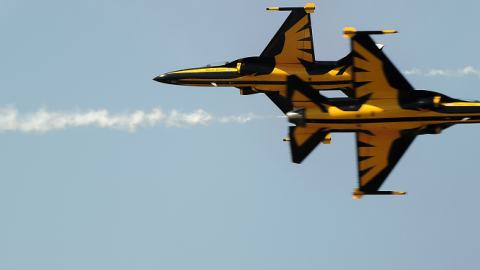Ever since the first Gulf War in 1990, the U.S. has enjoyed a monopoly on airplanes that by their design and materials are able to evade detection by radar. The F-117 Nighthawk, the B-2 bomber, the F-22 Raptor and now the F-35 Joint Strike Fighter have all symbolized a seemingly insurmountable American lead in this cutting-edge, potentially decisive military technology.
No longer. Stealth technology has come to the skies of Asia, and weapons makers there are proving that America's lead is not so insurmountable, after all. Unless the Pentagon and American defense companies prove to be as agile as the fighters they build, they might find themselves missing out on aspects of stealth's future development.
Japan's Mitsubishi stealthy ATD-X prototype will get its first test flight this year, out of which a full-blown fighter, the F-3, seems destined to emerge. China unveiled its stealth fighter, the J-20, in 2010. India has purchased the Russian T-50, the earliest attempt at breaking the U.S. stealth monopoly, and the most air-tested.
Japan's ATD-X is the most significant of these. Never before has an American ally sought to develop on its own a technology this sophisticated.
China is closely guarding the J-20's capabilities from prying eyes. Western defense experts can't even agree on whether it's meant to be an interceptor fighter or a fighter bomber. But China's airpower Achilles Heel has always been its poor engines, and there's no indication the J-20 has overcome that persistent problem.
Russia's Sukhoi T-50 was supposed to be a direct challenge to U.S. stealth hegemony—but it's been less than a success with the Indian Air Force. The Indians complain that the prototype's engines are unreliable, its radar poor and the air frame badly constructed. One even needed a wing patch to keep from pulling apart during high-stress maneuvers.
The Russians respond that the engines they've supplied are only temporary fits, as is the radar. But poor construction that allows for gaps and bad angles could mean a plane that is supposed to be stealthy isn't at all, spelling disaster in a combat situation. The Indians were thinking of buying 140 or more. Now they may be keener on returning the T-50s they have.
If Russia and China's stealth fighters seem like duds for now, Japan's by contrast looks to be the most promising for the future. For one thing, the Japanese learned a thing or two watching Americans deal with the virtues, as well as shortcomings, of their latest stealthy entry, the F-35 Joint Strike Fighter. Japan is even building 38 of the 42 F-35s it's buying from plane maker Lockheed Martin.
That said, the stealth features of the ATD-X demonstrators are entirely Mitsubishi's own design. And they are eye-opening—as are the future planes Japan plans to build from what it learns from the ATD-X.
First, the ATD-X has a sophisticated intake design that conforms better to a stealthy profile, as well as the usual internal weapons bays that preserve the plane's radar-defying lines. It has a self-repairing flight-control system that automatically compensates for damage to control surfaces that would usually cause a plane to crash, and keeps damaged surfaces from betraying the plane to radar.
The ATD-X also has fly-by-optics controls that are immune to electromagnetic interference, unlike the F-35. Its so-called "active electronically scanned array" radar can operate while the plane flies stealthily, or be used for electronic countermeasures—while future offshoot designs will carry arrays pointing both forward and aft.
As for the engine, Ishikawajima-Harima Heavy Industries is developing one that combines three-dimensional thrust vectoring, making it more agile than the F-35, with supercruise support like the F-22. This means the ATD-X will be able to reach supersonic speeds without going to afterburner, thus saving weight that would have to go to fuel for more weapons systems instead.
According to Aviation Week, Japan's Technical Research and Development Institute is already working an even more revolutionary "reflection suppression" technology that's distinct from, and superior to, standard stealth. All in all, Japanese designers are on their way toward the aviator's dream of a sixth-generation "intelligent" fighter that, if the optimists are right, could be operational in a decade and a half.
Will Japan's future stealth fighter by itself change the balance of power in Asia, or even challenge American airpower? Certainly not. But there's no denying a new airpower era is dawning in Asia, and not just in military terms.
The U.S. needs to find partners among its allies to develop and extend the technologies it will need to maintain its military edge in the air—especially if the Chinese and Russian plane designers are really catching up. Japan is an obvious choice for that partner. Its future fighters may not turn up on American radar screens—but its aerospace industry needs to be there, and soon.














